 |
Compressed Air Trams
By John Prentice |
 |
Compressed Air Trams
By John Prentice |
Oddly the commercial centre of Nantes on the Loire near the west coast of France has had a number of French 'firsts'. It was the first town with buses, the first compressed air tramway and the first French town with a 'new' second generation tramway.
The horse bus service began in 1825 from Place du Commerce to the suburb of Richebourg. The buses started outside a hat shop at Commerce run by a M. Omnes who had on his shop front the pun 'Omnes Omnibus', Latin for 'Omnes for All'. Some think this is the origin of the name omnibus in the context of such vehicles.
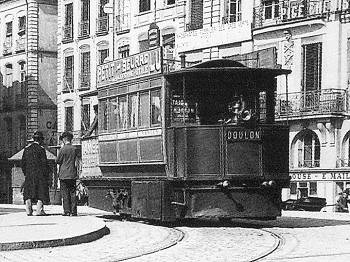 A Nantes Mékarski car of the first series in Place du Commerce around 1890.
A Nantes Mékarski car of the first series in Place du Commerce around 1890.
On 7th November 1876 Louis Mékarski obtained a concession to operate a mechanically propelled tramway on the route Chantenay-Doulon. The Compagnie des Tramways de Nantes was set up from 13th February 1879 and began a service of Mékarski compressed air cars between Doulon and the Gare Maritime, extending to Chantenay on 12th May 1880. Initially there was a fleet of 22 trams, 2 locos and four open top double deck trailers. The first line was just over 6 kilometres long, built to standard gauge and was mostly level, running along the quays of the Loire.
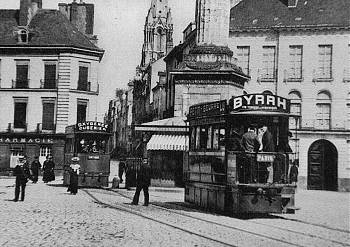 Mékarski cars at the base of the column in Place Louis XVI. The nearest car is of the later, side loading type.
Mékarski cars at the base of the column in Place Louis XVI. The nearest car is of the later, side loading type.
The single deck Mékarski trams carried 36 passengers, 18 inside on longitudinal seats plus 6 standing with 12 standing on the rear platform. Ten steel reservoir cylinders (7 main, 3 reserve) were fitted between the frames and were charged to 30 atmospheres, reduced to 4-6 atmospheres at the driving cylinders, which were 13.5 cm bore and 25.6 cm stroke, driving the front axle. The trams weighed 6.5 ton empty and 9 ton loaded. They were 2.22 m wide, 6.95 m long and 3.48 m high. The front driving wheels were 71 cm in diameter, the trailing wheels were 76 cm. The truck was by Brissonneau & Lotz, and bodywork by Clavier of Nantes. The locos had were slightly more powerful with 19 cm bore and 24.1 cm stroke cylinders driving two axles with 71 cm coupled wheels, although the coupling rods were later removed.
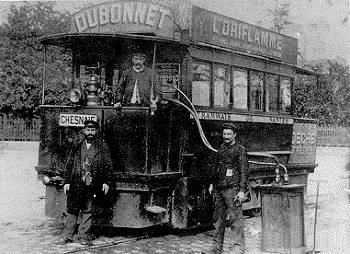 The charge point on the La Chesnaie route. The tram takes on air and steam (to re-heat the water in the bouillotte).
The charge point on the La Chesnaie route. The tram takes on air and steam (to re-heat the water in the bouillotte).
The journey on the initial route took 40 minutes and the car took 20 minutes to charge with air. The cars used a bouillotte, as previously described, two thirds full of hot water and steam at 160° C. The average speed was about 9 kph. Charging was done at two points, a main generating station at the depot at Doulon with four 50 hp steam engines, two working at any one time, and a two engine booster station at Chantenay. Each engine drove two pumps to provide compression in two stages at 6 and 30 atmospheres, this being stored in tanks. Sir Frederick Bramwell (of whom we will hear again) inspected the Nantes system and found that in the winter the cars ran 86 return trips per day (96 in the summer with 10 extra at peak times), i.e. 645 miles and used 15.64 lb. of coal per car mile.
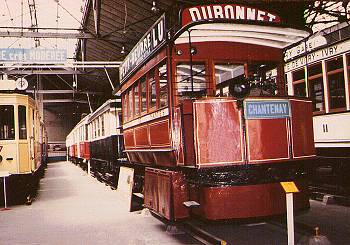 Original Nantes car 18 of 1879, seen in the Paris Transport Museum in 1992 (Photo: J.R.Prentice)
Original Nantes car 18 of 1879, seen in the Paris Transport Museum in 1992 (Photo: J.R.Prentice)
One of the original cars survived and was on display as part of the AMTUIR collection in the Paris Transport Museum. It is the only surviving compressed air tram in the world. At the end of 1992, this unique original Mékarski car (Number 18) was returned to Nantes where it was stored in the Trocardiere Depot at the southerly end of the new route 2 (Trocardiere to Ecole Centrale Sup de Co), pending decisions on the future location of the AMTUIR collection.It has now returned to Paris.
A second route running north-south and using the Loire Bridges crossing the original route was opened on 14th June 1888 from Bourse to Pirmil, extended to Route de Rennes on 17th August 1890.
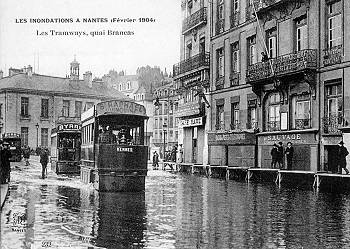 Quai Brancas in February 1904 when the River Loire flooded. Compressed air trams were still able to run, as they also did in Paris during the floods of 1910.
Quai Brancas in February 1904 when the River Loire flooded. Compressed air trams were still able to run, as they also did in Paris during the floods of 1910.
Further new extensions were opened from 1897 to reach Gare 1'Etat in July 1897, Route de Paris in October, Pont Rousseau in June 1898 with a new route from Place St. Pierre- La Chesnaie opened in December 1898 and Pont Morand-Place du Commerce in October 1900, along the banks of the River Erdre and giving a Route de Rennes-Pont Rousseau direct line.
Tracks on the quays was double but elsewhere the lines were single due to narrow streets. On the straight it was lightly spiked to transverse oak sleepers with cast iron chairs at 1.45 m spacing and used Marlin 17 kg/m rail with a 11 kg/m check rail. On curves, grooved 22 kg/m grooved tram rail with wrought iron tie bars was laid on longitudinal oak sleepers. There were several railway level crossings.
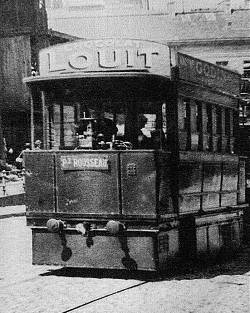 A second series Mékarski car at the Petit-Hollande market. It is pulling a double-deck trailer, a rare occurence.
A second series Mékarski car at the Petit-Hollande market. It is pulling a double-deck trailer, a rare occurence.
An additional 32 motor cars were added in 1898-1900, each being more powerful than the first series running at 60 atmospheres charge and with both axles driven. The first series cars had the entrance at the rear between the rails, but these had side entry to allow trailer operation.
The last horse bus ran in 1898 with trams then carrying all the traffic which by 1910 had grown to 39 km of route carrying 12 million passengers per year. The fleet by then had expanded to 94 trams (including the original 22), 3 locos and 10 open top trailers.
Sadly by this time the air cars were old fashioned and so in 1911 it was decided to replace them with 100 electric cars on Brill trucks. This replacement began in November 1913 with the Route de Rennes-Pont Rousseau route but was slowed down by the war, with the last Mékarski car running along the quays in 1917.
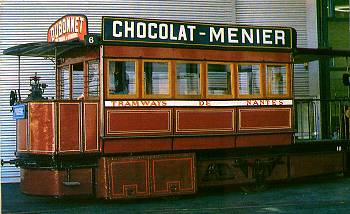 Museum car 18 back in Nantes, at the Trocardiere depot in November 1992 (Photo: R.G.Manders)
Museum car 18 back in Nantes, at the Trocardiere depot in November 1992 (Photo: R.G.Manders)
The Nantes tram system closed on 25th January 1958, but another first for Nantes was the opening of the new tramway on 7th January 1985. On 22nd April 1989 this first route was extended by 1.9 km from Haluchere to La Beaujoire and at the inauguration there was a parade of trams from Dalby (depot) to Place du Commerce, when the Mékarski car from the Paris museum made a brief return to the streets of Nantes, 110 years after its original first run.
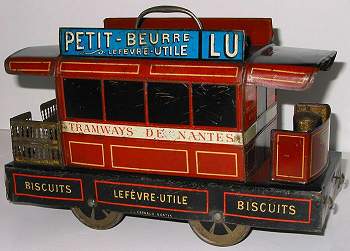 In 1898, J.J. Carnaud of Nantes produced this biscuit tin in the form of a model compressed air tram. Lefèvre-Utile was France's premier biscuit company and was also based in Nantes. After eating the biscuits, the tin could be used to keep cigars in.
In 1898, J.J. Carnaud of Nantes produced this biscuit tin in the form of a model compressed air tram. Lefèvre-Utile was France's premier biscuit company and was also based in Nantes. After eating the biscuits, the tin could be used to keep cigars in.
![]() Go now to Next Section
Go now to Next Section
![]() Return to Index
Return to Index